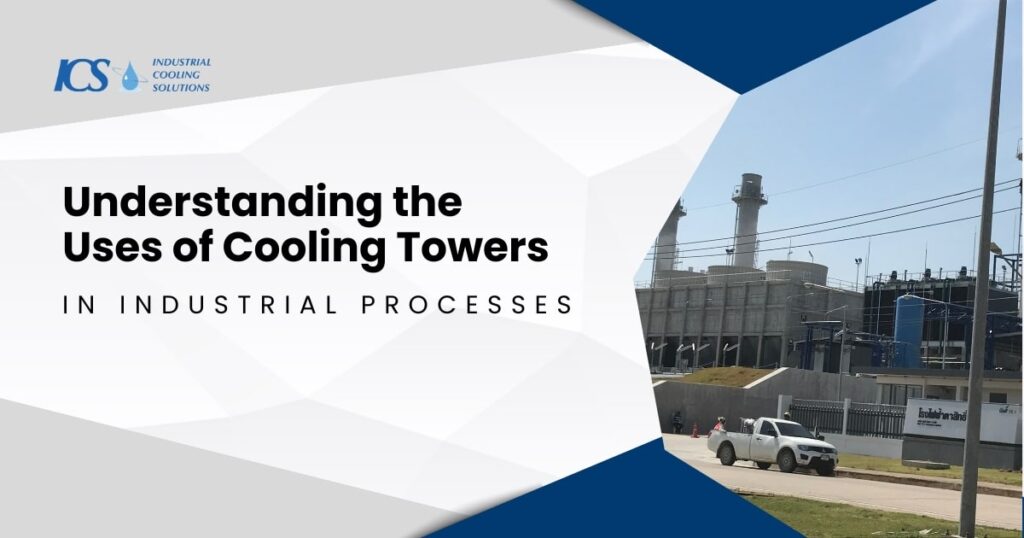A cooling tower is a vital heat removal system used in various industrial processes to transfer excess heat from machinery, equipment, or processed fluids into the atmosphere. These towers utilize water as a cooling medium, leveraging the principles of evaporative cooling to dissipate latent heat well. In this blog we will understand the cooling towers extensively and also explore the usage of cooling towers.
Table of Contents
Purpose of cooling towers
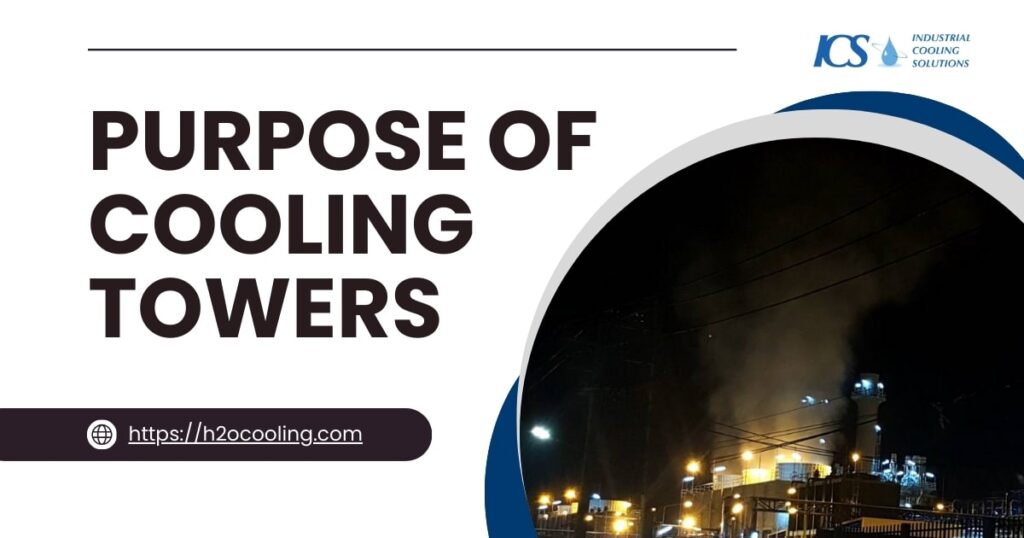
By evaporating a small portion of the water recirculated through the unit, cooling towers effectively lower the temperature of the remaining water, which is then recirculated back into the cooling system again.
In industrial settings, managing heat is critical to ensure the smooth operation of machinery and processes. Overheating can lead to equipment failures, reduced efficiency, and increased operational costs.
Thus, cooling towers serve as a cornerstone in maintaining optimal ambient temperature and levels, ensuring both safety and efficiency.
Importance of Heat Energy Removal in Industrial Processes
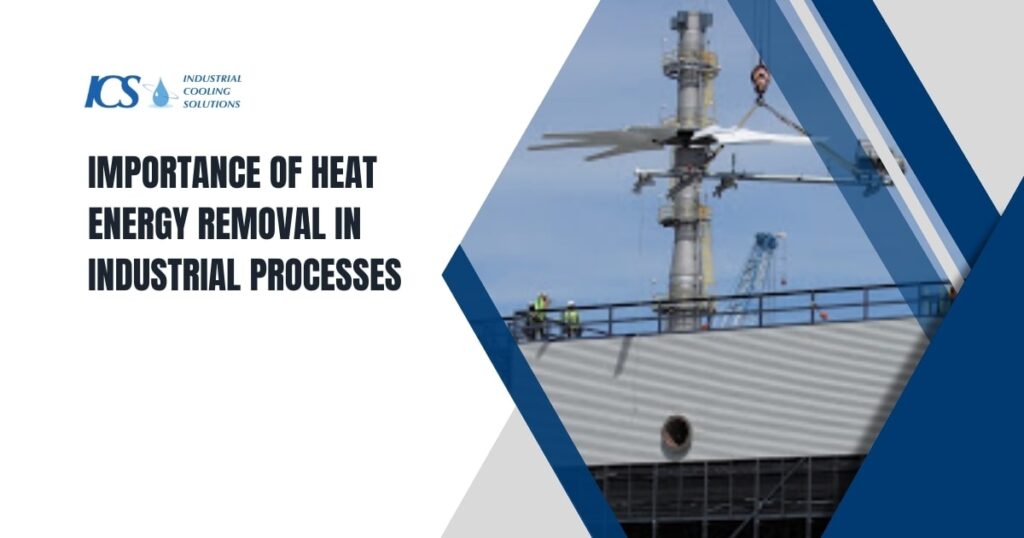
Heat energy removal is essential across various industrial sectors for several reasons:
- Prevention of Overheating: Continuous operation of industrial machinery generates significant amounts of heat. Without effective heat removal, this can lead to overheating, causing equipment malfunction or failure. Cooling towers prevent such scenarios by efficiently dissipating excess heat.
- Reduction of Energy Consumption: By maintaining optimal operating temperatures, cooling towers enhance the efficiency of industrial processes, leading to lower energy consumption. This not only cuts operational costs but also contributes to sustainability efforts by reducing the overall energy footprint.
- Increased Efficiency: Proper heat management ensures that machinery operates within its ideal temperature range, enhancing performance and longevity. This leads to more consistent output and reduces the likelihood of downtime caused by thermal issues.
How Cooling Tower Systems Work?

Cooling tower systems work through following methods:
Heat Transfer Methods in Cooling Towers
Cooling towers mainly operate on evaporative cool, one of the best heat exchange means that involves the use of water droplets. Here’s how it works:
- Evaporative Cooling: This process involves taking away heat by half evaporation of water. This is because during the warming of the water, air is either drawn or forced through the fill material within the cooling tower. Mention the effect of throw and toss where the water and air mix together resulting in evaporation whereby some of the water warms the rest of the water, causing it to cool down. The cooled water is then channeled and pumped back to the industrial system at the same levels it was obtained from.
Air Flow Generation Methods in Cooling Towers
Air interchange plays a vital role in the cooling process because of that. Cooling towers achieve this through two primary methods:
- Natural Draft Cooling Towers: These towers basically utilize natural air circulation to act as cooler for the circuits. The design is usually characterised by a high chimney-Like structure where air warmed due to infrared radiation is allowed to rise higher than cool atmospheric air due cooler density. The warm air at the top of the tower rises as it is replaced by the cool air entering the structure from the lower part thus enabling unending air flow in the structure. Natural draft towers are usually applied in large power stations, and industries with massive cooling water demand, due to their high heat handling capabilities.
- Induced Draft Cooling Towers: In these towers, there exist fans that aid in drawing air from the tower into the building. Due to the induced draft mechanism the flow or the air will be more forceful and consistent to offer better cooling results. Although they are slightly better than natural draft towers, induced draft systems have high energy demands caused by the fans. It is extensively employed in almost all industries that require exact temperature regulation and superior cooling performance.
Types of Cooling Towers
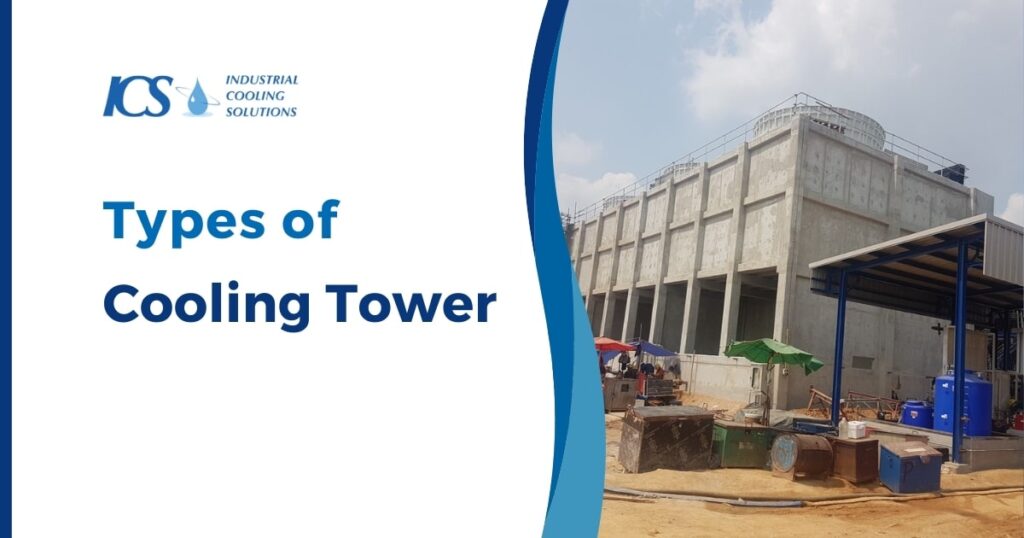
There are following types of cooling towers:
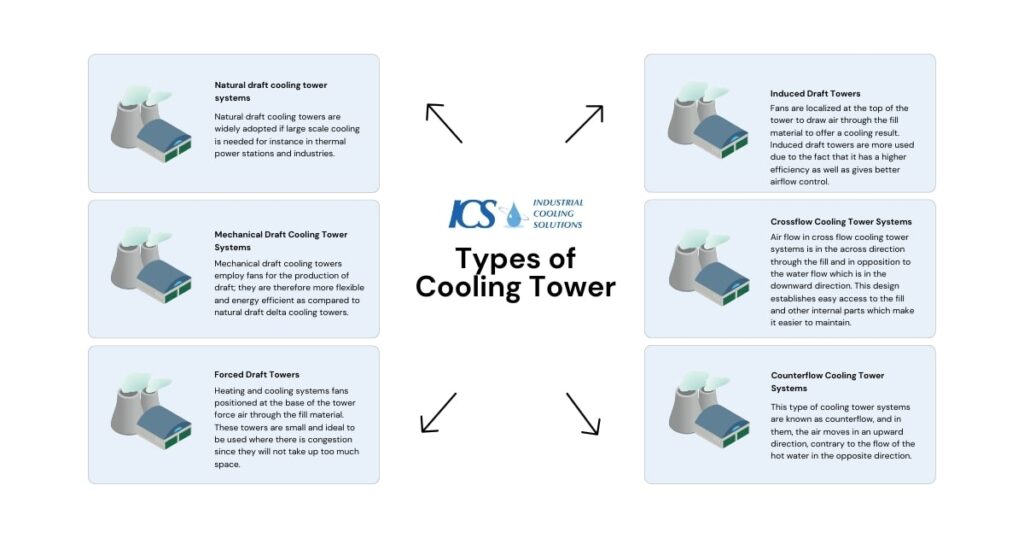
Natural draft cooling tower systems
Natural draft cooling towers are widely adopted if large scale cooling is needed for instance in thermal power stations and industries.
These towers are based on the concept of forced convection where a stack effect is formed due to the hot air rising and the cooled air is then pulled from the bottom.
Operation: The large mass of the tower with heights stretching in some designs in hyperboles contributes to the natural draft mechanisms.
It is through this hot water that is produced by the industrial process that water is sprayed over the fill material within the tower so that the surfaces are expanded, thus allowing for better heat exchange.
When the water is dripping, the air is sucked or condenser water pulled up thus enhancing evaporation and creates a cooling effect.
Advantages:
- No requirement for mechanical fans means low operating expenses as there are no parts that would wear out, need replacement or become damaged frequently.
- Ideal for consumption by large organizations or establishments that require huge amounts of cooling.
Disadvantages:
- Disadvantages include small scale of operations, mammoth land space requirements, and proportionately high costs of establishment.
- Depending on the weather conditions outside that may in one way or the other hinder the efficiency of the gadget when in use.
Mechanical Draft Cooling Tower Systems
Mechanical draft cooling towers employ fans for the production of draft; they are therefore more flexible and energy efficient as compared to natural draft delta cooling towers. These systems can be further categorized into forced draft and induced draft cooling towers work as:
Forced Draft Towers:
Heating and cooling systems fans positioned at the base of the tower force air through the fill material. These towers are small and ideal to be used where there is congestion since they will not take up too much space.
Induced Draft Towers:
Fans are localized at the top of the tower to draw air through the fill material to offer a cooling result. Induced draft towers are more used due to the fact that it has a higher efficiency as well as gives better airflow control.
Advantages:
- The high cooling efficiency was observed along with better control of the air passing through the units.
- It is ideal for use in many industries or factories that have the above requirements.
Disadvantages:
- They addressed some negative aspects of the fan as the functional costs, particularly the fan operational costs.
- Needs to be tendered often in order to check the efficiency of the fan and motor system.
Crossflow Cooling Tower Systems
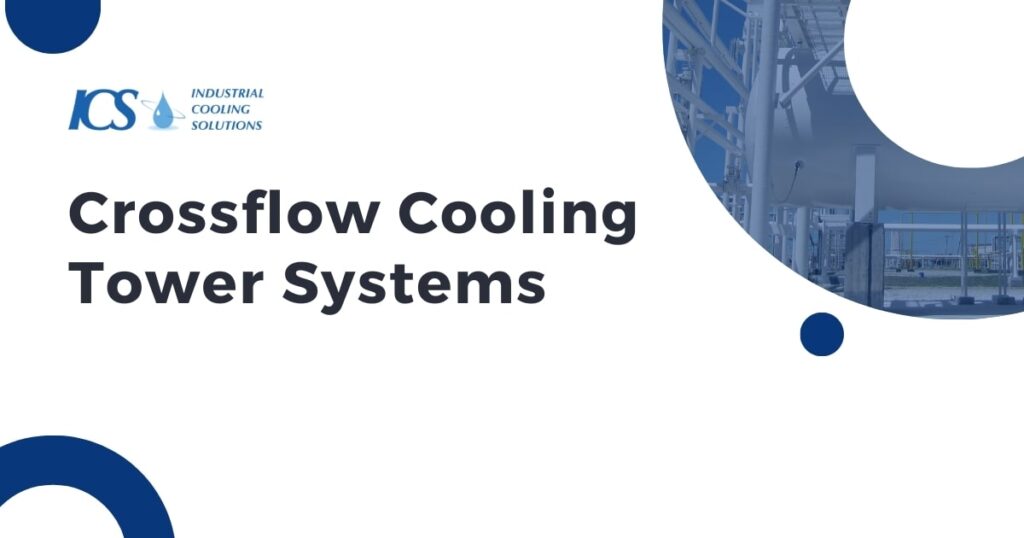
Air flow in cross flow cooling tower systems is in the across direction through the fill and in opposition to the water flow which is in the downward direction. This design establishes easy access to the fill and other internal parts which make it easier to maintain.
Operation: Hot water circulation is accomplished through distribution basins to the surface area of fill material. When water is falling downward while air rises as it rushes horizontally across the fill area, evaporation is enhanced to cool the air.
Advantages:
- Maintainability: Inability to access the equipment from either side for maintenance and inspection purposes.
- The design aids in ensuring that pumping requirements are reduced to lowest levels possible.
Disadvantages:
- Oil is cooler than the vapor leaving the column; thus, less efficient in terms of heat transfer compared to counterflow systems.
- Larger footprint due to the layout of the fan blades that allow air to flow horizontally.
Counterflow Cooling Tower Systems
This type of cooling tower systems are known as counterflow, and in them, the air moves in an upward direction, contrary to the flow of the hot water in the opposite direction. This counter current flow pattern optimizes the heat exchange coefficient by achieving higher thermal gradients between the air and cooled water temperature.
Operation: High pressure air is supplied in the form of hot water to the fill material while low pressure air and warm water is extracted at the bottom and rises. The flow in the counter-current manner provides the maximum contact with the least hot air and cold water used, thus making the best utilization of the cooler.
Advantages:
- It possesses enhanced heat transfer rate than crossflow systems.
- They are still less complex and require less space than larger versions.
Disadvantages:
- This is so because the counterflow design increases the pumping requirement needed to circulate the two liquids.
- It is slightly more complex and compact in method and design, which has an impact on its maintenance.
Industrial Applications of Cooling Towers
Following are the industrial application of cooling towers:
Cooling Towers in Power Generation
In all forms of thermal power plants however, including nuclear power plants, there exist cooling towers that are crucial in cooling the waste heat that is produced during the process of electricity generation. This heat is usually taken from the steam cycle to the rate of the cooling water and the water is then taken to the other uses of cooling tower for cooling before being pumped back again.
Benefits:
- It also ensures operational efficiency of turbines and other equipment by conducting tests and maintenance.
- Promotes a stable temperature control, to avoid exceeding the maximum levels that may cause damage to the equipment.
Cooling Towers in Chemical Processing
Examples of heating equipment include cooling towers, which are used to tackle heat produced through exothermic reactions and other processes in chemical processing plants. Cooling remains a critical component of reactions to sustain its control, enhanced product quality and operation efficiency.
Benefits:
- This helps to mitigate instances of thermal degradation of products.
- Contributes to the quality and consistency by keeping the temperature stable and improving the process control and safety.
Cooling Towers in Oil Refineries
Oil refineries use large cooling towers, because the process of refining oil is both complex and energy intensive, requiring unlimited power in order to run efficient cooling processes.
With more knowledge of different types of equipment in a refinery, it is important to understand that cooling towers in oil refineries are used for cooling different process stream such as distillation columns, heat exchangers and condensers. Proper and smaller cooling towers is a crucial factor to protect refining processes and maintain them at an optimal pace.
Benefits:
- They support the efficient separation and purification of the various hydrocarbons in an efficient manner.
- An essential aid in avoiding high temperatures and pressure build up, thus contributing to the safety of operations.
Advantages of Cooling Towers in HVAC Industries
Following are the advantages of cooling towers in HVAC industries:
Energy Efficiency and Cost Savings through Heat Energy Removal
Cooling towers ensure the efficiency of energy and use within industrial processes and produce cost savings. These systems utilize as little as 2% of the freshwater—once repetitively used in process industrial facilities for cooling towers or air conditioning—and use nearly all water, which is only at 98%, and require little energy.
Advantages:
- A direct benefit that can be inferred is lower operational costs due to minimal energy and water use.
- Optimization of different parameters of industries to improve the rate of production and certain time periods during production.
Environmental benefits of Cooling Towers
As is evident from the discussion above, cooling towers are effectively designed to serve as human comfort cooling air conditioning systems or as open, water-cooled industrial heat exchangers.
Cooling towers stand to be many fold environmentally beneficial making them a perfect solution to industrial cooling needs. They help to cut back on the use of various water treatment chemicals and minimize the amount of heat that is allowed to dissipate into the environment in industrial operations.
Advantages:
- Saves on water resources in the sense that cooling water is recycled.
- Minimizes thermal pollution through efficiently dispersing waste heat of the process into the air.
Operation and maintenance of a cooling tower
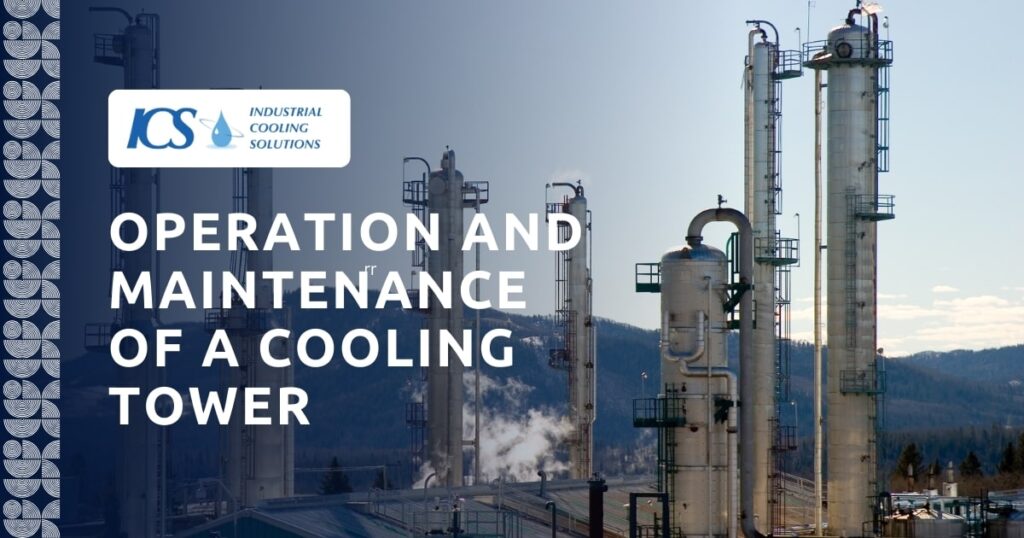
Water Treatment and Maintenance in Cooling Towers
Cooling towers are an essential part of HVAC systems for maintaining internal temperatures and requiring proper water treatment and management to avoid contamination that could negatively impact equipment or human health.
Water treatment is one that is vital in ensuring that these towers work efficiently with the shortest possible service spans. To prevent scale formation, corrosion and the quantity of microorganisms growing in the circulating water it the circulating water will have to be treated.
Water Treatment:
- Scale Prevention: These deposits, which may occur on the scale, can hinder the flow of water and compromise the heat transfer. Some of the chemicals used for water treatment include; Scale inhibitors – They are used to treat water to keep it from forming scale.
- Corrosion Control: Many towers contain metal structures and pipelines that get exposed to chemical or aggressive environmentally; thus, suffer from corrosion. This is to minimize the effects of corrosion on metal surfaces with the use of inhibitors that dissolve in the water.
- Microbial Control: It is important to note that the water in the cooling towers is warm and saturated, and that can lead to the growth of microorganisms like bacteria and algae. Biocides are typically employed in order to inhibit the growth of bacteria and halt the process of biofouling.
Importance of Regular Maintenance in Cooling Towers
Cooling towers are exposed to harsh weather conditions, chemicals, dust and other particles that may pose a risk on the unit or spoil the water that flows through it. For this reason, regular maintenance of cooling towers is very crucial to ensure that the fluid flowing through the cooling tower applications is clean and safe for use and that the tower is strong enough to withstand daily use.
To achieve high operational efficiency and maintain an extended useful life of cooling towers, it is required to perform its maintenance periodically. Maintenance activities include:
- Inspection and Cleaning: Periodic examinations enable the timely evaluation of problems such as scaling, corrosion, and fouling surfaces. Maintenance procedures such as cleaning the fill material and other components of the heat transfer equipment enhances airflow and heat transfer rates in the equipment.
- Water Quality Monitoring: The techniques of assessing and maintaining water quality include pH, conductivity, and biocide, among others, in order to ensure the efficiency of the water.
- Mechanical Maintenance: Routine checking and servicing of fans, motors, and pumps SECURE THE operation and prevent failures.
Cooling Tower System Design and Sizing
Cycle of concentration
Cycles of concentration are cycles that take place in cooling towers where knowledge and other materials are concentrated.
Cycle of concentration refers to the new water introduced to the process of making steam whereas circulating water refers to the water that is reused in the process after cooling it to its required temperature.
Importance:
- Efficiency: Positive correlation to higher cycles of concentration entails that there are fewer requirements for fresh make-up water hence promoting water conservation.
- Water Quality: Minimizing interruptions of the cyclic concentration preserves the solubility of the dissolved minerals and reduces chances of scaling and fouling formation.
Wet Bulb Temperature and Its Importance
The wet bulb temperature is a critical parameter in the design and operation of entire system of cooling towers. It represents the lowest temperature to which water can be cooled through the evaporative cooling towers, considering the ambient air temperature and humidity.
Significance:
- Design Basis: The wet bulb temperature is used to determine the theoretical minimum temperature of the cooled water, guiding the design and sizing of the cooling tower.
- Performance: Understanding the wet bulb temperature helps in assessing the cooling tower’s performance under varying climatic conditions.
Conclusion
Cooling towers play an indispensable role in transferring heat used in industrial processes, providing efficient heat energy removal, reducing energy consumption, and enhancing overall operational efficiency. By leveraging the principles of evaporative cooling, these closed circuit cooling towers manage heat effectively, ensuring the smooth operation of machinery and processes.
Regular maintenance and effective water treatment are crucial to the longevity and performance of cooling towers, while careful design and sizing based on factors like cycles of concentration and wet bulb temperature ensure optimal operation. In various industrial applications, from power generation to chemical and food processing plants and oil refining, cooling towers offer significant benefits, including energy efficiency, cost savings, and environmental sustainability.

